Project Management Techniques
VerifiedAdded on 2023/04/20
|17
|4146
|262
AI Summary
This document provides an overview of project management techniques for an IoT-based healthcare application. It covers project objectives, scope, deliverables, and constraints, as well as the project structure and stakeholder management. The document also discusses the skills required for a project manager and includes a work breakdown structure.
Contribute Materials
Your contribution can guide someone’s learning journey. Share your
documents today.
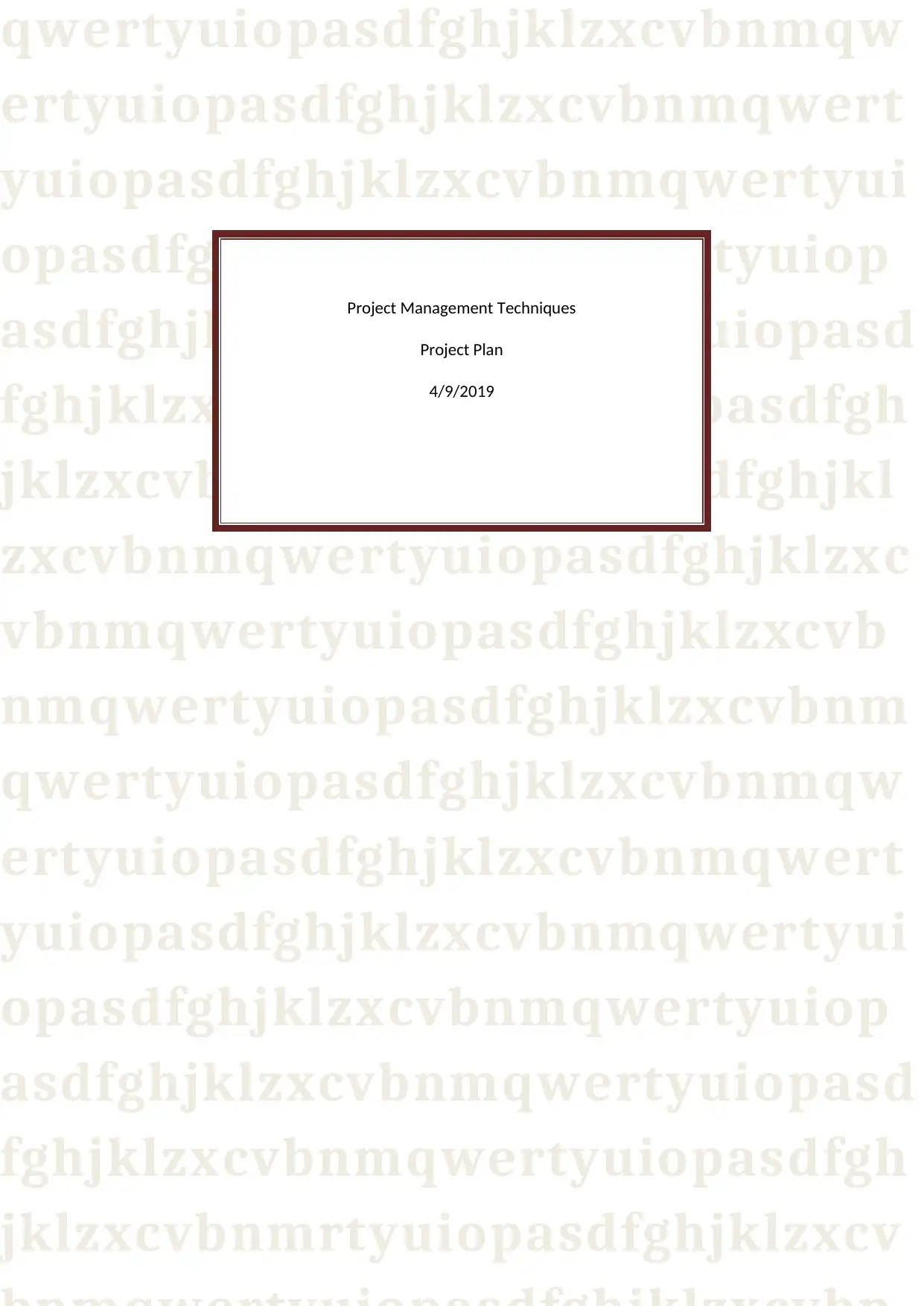
qwertyuiopasdfghjklzxcvbnmqw
ertyuiopasdfghjklzxcvbnmqwert
yuiopasdfghjklzxcvbnmqwertyui
opasdfghjklzxcvbnmqwertyuiop
asdfghjklzxcvbnmqwertyuiopasd
fghjklzxcvbnmqwertyuiopasdfgh
jklzxcvbnmqwertyuiopasdfghjkl
zxcvbnmqwertyuiopasdfghjklzxc
vbnmqwertyuiopasdfghjklzxcvb
nmqwertyuiopasdfghjklzxcvbnm
qwertyuiopasdfghjklzxcvbnmqw
ertyuiopasdfghjklzxcvbnmqwert
yuiopasdfghjklzxcvbnmqwertyui
opasdfghjklzxcvbnmqwertyuiop
asdfghjklzxcvbnmqwertyuiopasd
fghjklzxcvbnmqwertyuiopasdfgh
jklzxcvbnmrtyuiopasdfghjklzxcv
Project Management Techniques
Project Plan
4/9/2019
ertyuiopasdfghjklzxcvbnmqwert
yuiopasdfghjklzxcvbnmqwertyui
opasdfghjklzxcvbnmqwertyuiop
asdfghjklzxcvbnmqwertyuiopasd
fghjklzxcvbnmqwertyuiopasdfgh
jklzxcvbnmqwertyuiopasdfghjkl
zxcvbnmqwertyuiopasdfghjklzxc
vbnmqwertyuiopasdfghjklzxcvb
nmqwertyuiopasdfghjklzxcvbnm
qwertyuiopasdfghjklzxcvbnmqw
ertyuiopasdfghjklzxcvbnmqwert
yuiopasdfghjklzxcvbnmqwertyui
opasdfghjklzxcvbnmqwertyuiop
asdfghjklzxcvbnmqwertyuiopasd
fghjklzxcvbnmqwertyuiopasdfgh
jklzxcvbnmrtyuiopasdfghjklzxcv
Project Management Techniques
Project Plan
4/9/2019
Secure Best Marks with AI Grader
Need help grading? Try our AI Grader for instant feedback on your assignments.

Project Management Techniques
Table of Contents
Project Overview...................................................................................................................................2
Project Background...........................................................................................................................2
Project Objectives..............................................................................................................................2
Project Scope & Exclusions...............................................................................................................2
Project Deliverables & Constraints....................................................................................................3
Project Structure................................................................................................................................4
Project Stakeholders..............................................................................................................................4
Project Manager Skills.......................................................................................................................7
Work Breakdown Structure...................................................................................................................7
Key Skills of Project Manager...........................................................................................................9
Project Schedule..................................................................................................................................10
Technique 1 – Phased Estimation....................................................................................................10
Technique 2 – Bottom-up Estimations (Critical Path Method)........................................................12
Use of Techniques by Project Manager...........................................................................................13
Deal with Slippage of Schedule.......................................................................................................14
Key Skills of Project Manager.........................................................................................................14
Conclusion...........................................................................................................................................15
References...........................................................................................................................................16
1
Table of Contents
Project Overview...................................................................................................................................2
Project Background...........................................................................................................................2
Project Objectives..............................................................................................................................2
Project Scope & Exclusions...............................................................................................................2
Project Deliverables & Constraints....................................................................................................3
Project Structure................................................................................................................................4
Project Stakeholders..............................................................................................................................4
Project Manager Skills.......................................................................................................................7
Work Breakdown Structure...................................................................................................................7
Key Skills of Project Manager...........................................................................................................9
Project Schedule..................................................................................................................................10
Technique 1 – Phased Estimation....................................................................................................10
Technique 2 – Bottom-up Estimations (Critical Path Method)........................................................12
Use of Techniques by Project Manager...........................................................................................13
Deal with Slippage of Schedule.......................................................................................................14
Key Skills of Project Manager.........................................................................................................14
Conclusion...........................................................................................................................................15
References...........................................................................................................................................16
1
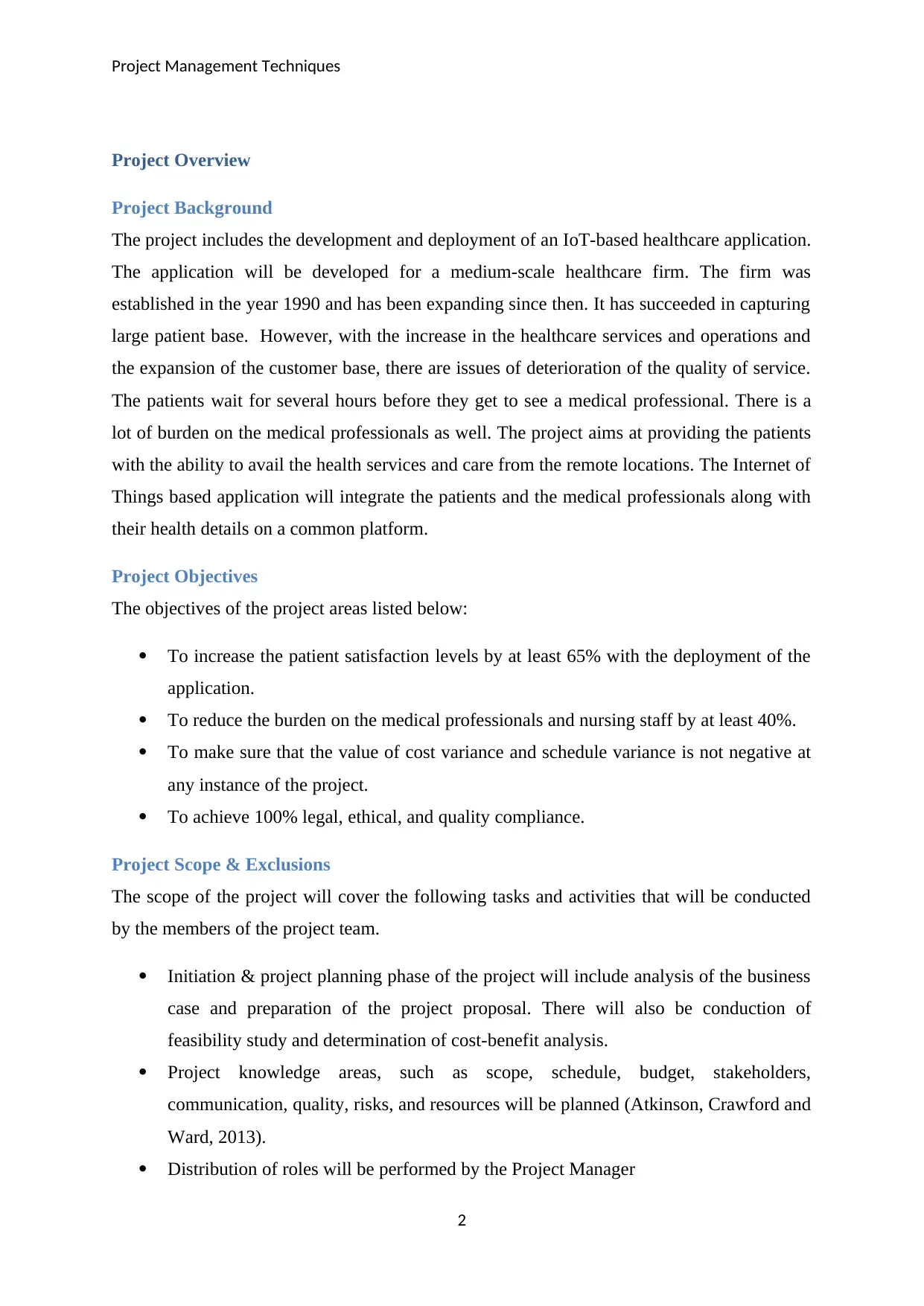
Project Management Techniques
Project Overview
Project Background
The project includes the development and deployment of an IoT-based healthcare application.
The application will be developed for a medium-scale healthcare firm. The firm was
established in the year 1990 and has been expanding since then. It has succeeded in capturing
large patient base. However, with the increase in the healthcare services and operations and
the expansion of the customer base, there are issues of deterioration of the quality of service.
The patients wait for several hours before they get to see a medical professional. There is a
lot of burden on the medical professionals as well. The project aims at providing the patients
with the ability to avail the health services and care from the remote locations. The Internet of
Things based application will integrate the patients and the medical professionals along with
their health details on a common platform.
Project Objectives
The objectives of the project areas listed below:
To increase the patient satisfaction levels by at least 65% with the deployment of the
application.
To reduce the burden on the medical professionals and nursing staff by at least 40%.
To make sure that the value of cost variance and schedule variance is not negative at
any instance of the project.
To achieve 100% legal, ethical, and quality compliance.
Project Scope & Exclusions
The scope of the project will cover the following tasks and activities that will be conducted
by the members of the project team.
Initiation & project planning phase of the project will include analysis of the business
case and preparation of the project proposal. There will also be conduction of
feasibility study and determination of cost-benefit analysis.
Project knowledge areas, such as scope, schedule, budget, stakeholders,
communication, quality, risks, and resources will be planned (Atkinson, Crawford and
Ward, 2013).
Distribution of roles will be performed by the Project Manager
2
Project Overview
Project Background
The project includes the development and deployment of an IoT-based healthcare application.
The application will be developed for a medium-scale healthcare firm. The firm was
established in the year 1990 and has been expanding since then. It has succeeded in capturing
large patient base. However, with the increase in the healthcare services and operations and
the expansion of the customer base, there are issues of deterioration of the quality of service.
The patients wait for several hours before they get to see a medical professional. There is a
lot of burden on the medical professionals as well. The project aims at providing the patients
with the ability to avail the health services and care from the remote locations. The Internet of
Things based application will integrate the patients and the medical professionals along with
their health details on a common platform.
Project Objectives
The objectives of the project areas listed below:
To increase the patient satisfaction levels by at least 65% with the deployment of the
application.
To reduce the burden on the medical professionals and nursing staff by at least 40%.
To make sure that the value of cost variance and schedule variance is not negative at
any instance of the project.
To achieve 100% legal, ethical, and quality compliance.
Project Scope & Exclusions
The scope of the project will cover the following tasks and activities that will be conducted
by the members of the project team.
Initiation & project planning phase of the project will include analysis of the business
case and preparation of the project proposal. There will also be conduction of
feasibility study and determination of cost-benefit analysis.
Project knowledge areas, such as scope, schedule, budget, stakeholders,
communication, quality, risks, and resources will be planned (Atkinson, Crawford and
Ward, 2013).
Distribution of roles will be performed by the Project Manager
2
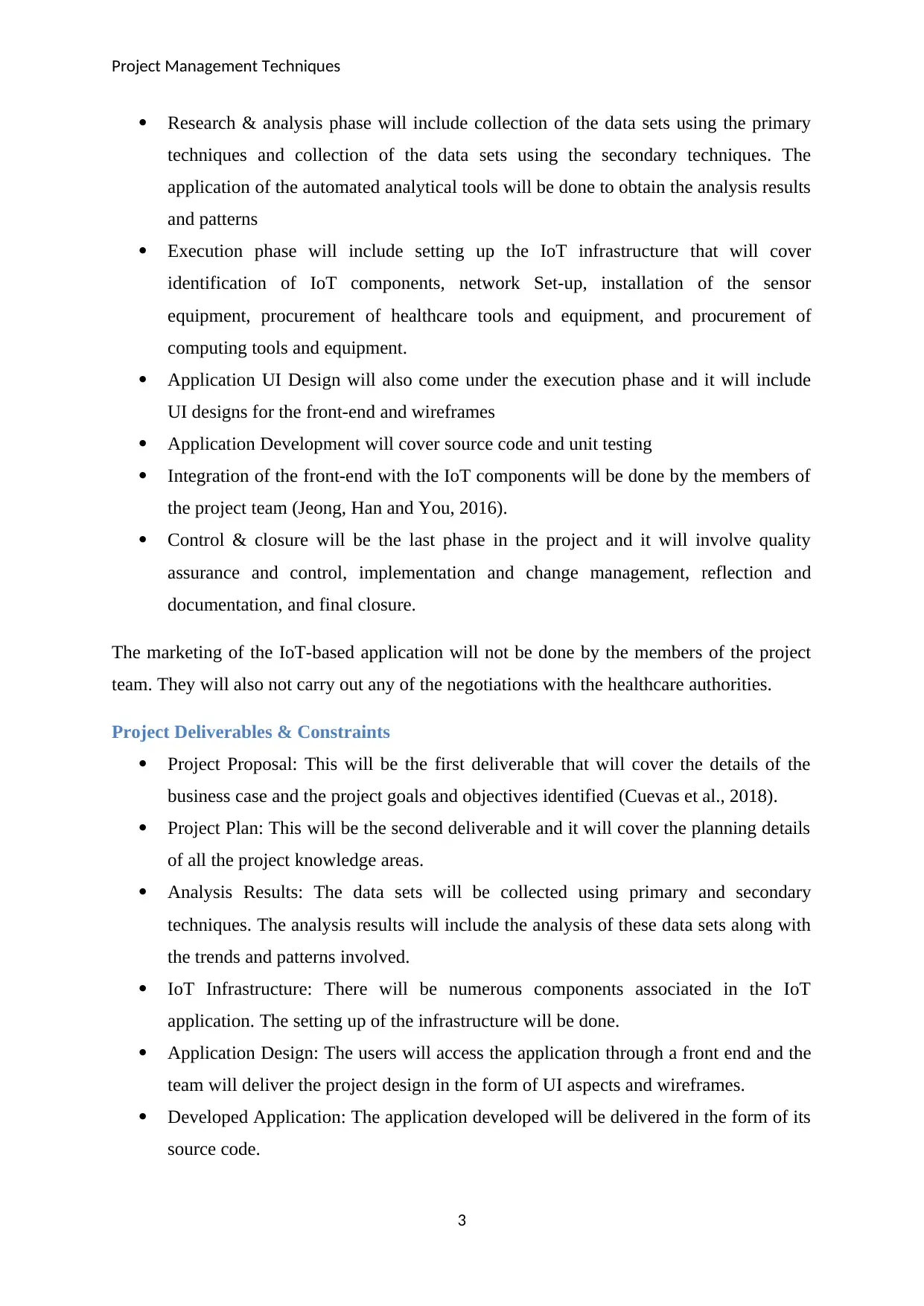
Project Management Techniques
Research & analysis phase will include collection of the data sets using the primary
techniques and collection of the data sets using the secondary techniques. The
application of the automated analytical tools will be done to obtain the analysis results
and patterns
Execution phase will include setting up the IoT infrastructure that will cover
identification of IoT components, network Set-up, installation of the sensor
equipment, procurement of healthcare tools and equipment, and procurement of
computing tools and equipment.
Application UI Design will also come under the execution phase and it will include
UI designs for the front-end and wireframes
Application Development will cover source code and unit testing
Integration of the front-end with the IoT components will be done by the members of
the project team (Jeong, Han and You, 2016).
Control & closure will be the last phase in the project and it will involve quality
assurance and control, implementation and change management, reflection and
documentation, and final closure.
The marketing of the IoT-based application will not be done by the members of the project
team. They will also not carry out any of the negotiations with the healthcare authorities.
Project Deliverables & Constraints
Project Proposal: This will be the first deliverable that will cover the details of the
business case and the project goals and objectives identified (Cuevas et al., 2018).
Project Plan: This will be the second deliverable and it will cover the planning details
of all the project knowledge areas.
Analysis Results: The data sets will be collected using primary and secondary
techniques. The analysis results will include the analysis of these data sets along with
the trends and patterns involved.
IoT Infrastructure: There will be numerous components associated in the IoT
application. The setting up of the infrastructure will be done.
Application Design: The users will access the application through a front end and the
team will deliver the project design in the form of UI aspects and wireframes.
Developed Application: The application developed will be delivered in the form of its
source code.
3
Research & analysis phase will include collection of the data sets using the primary
techniques and collection of the data sets using the secondary techniques. The
application of the automated analytical tools will be done to obtain the analysis results
and patterns
Execution phase will include setting up the IoT infrastructure that will cover
identification of IoT components, network Set-up, installation of the sensor
equipment, procurement of healthcare tools and equipment, and procurement of
computing tools and equipment.
Application UI Design will also come under the execution phase and it will include
UI designs for the front-end and wireframes
Application Development will cover source code and unit testing
Integration of the front-end with the IoT components will be done by the members of
the project team (Jeong, Han and You, 2016).
Control & closure will be the last phase in the project and it will involve quality
assurance and control, implementation and change management, reflection and
documentation, and final closure.
The marketing of the IoT-based application will not be done by the members of the project
team. They will also not carry out any of the negotiations with the healthcare authorities.
Project Deliverables & Constraints
Project Proposal: This will be the first deliverable that will cover the details of the
business case and the project goals and objectives identified (Cuevas et al., 2018).
Project Plan: This will be the second deliverable and it will cover the planning details
of all the project knowledge areas.
Analysis Results: The data sets will be collected using primary and secondary
techniques. The analysis results will include the analysis of these data sets along with
the trends and patterns involved.
IoT Infrastructure: There will be numerous components associated in the IoT
application. The setting up of the infrastructure will be done.
Application Design: The users will access the application through a front end and the
team will deliver the project design in the form of UI aspects and wireframes.
Developed Application: The application developed will be delivered in the form of its
source code.
3
Secure Best Marks with AI Grader
Need help grading? Try our AI Grader for instant feedback on your assignments.
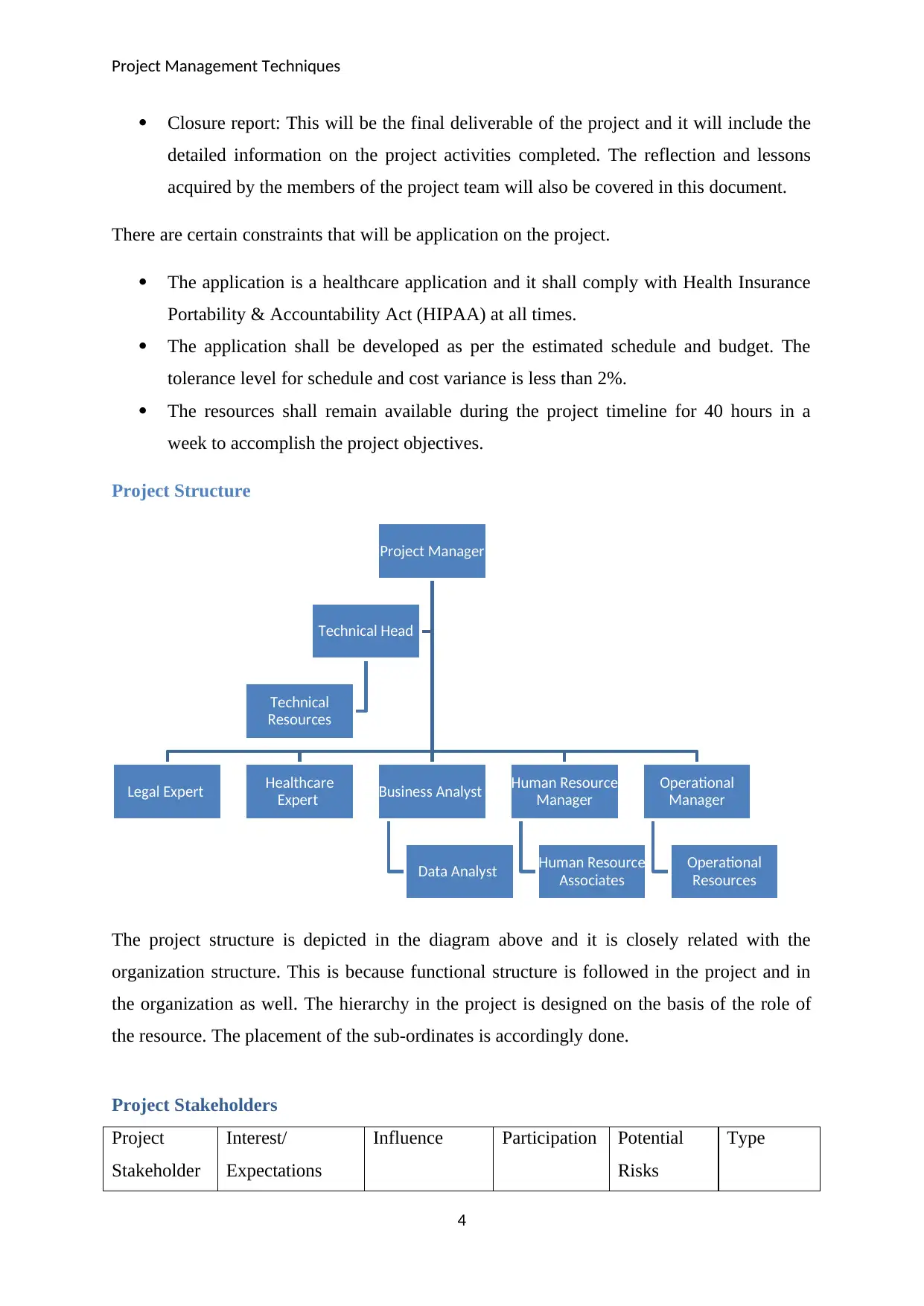
Project Management Techniques
Closure report: This will be the final deliverable of the project and it will include the
detailed information on the project activities completed. The reflection and lessons
acquired by the members of the project team will also be covered in this document.
There are certain constraints that will be application on the project.
The application is a healthcare application and it shall comply with Health Insurance
Portability & Accountability Act (HIPAA) at all times.
The application shall be developed as per the estimated schedule and budget. The
tolerance level for schedule and cost variance is less than 2%.
The resources shall remain available during the project timeline for 40 hours in a
week to accomplish the project objectives.
Project Structure
The project structure is depicted in the diagram above and it is closely related with the
organization structure. This is because functional structure is followed in the project and in
the organization as well. The hierarchy in the project is designed on the basis of the role of
the resource. The placement of the sub-ordinates is accordingly done.
Project Stakeholders
Project
Stakeholder
Interest/
Expectations
Influence Participation Potential
Risks
Type
4
Project Manager
Legal Expert Healthcare
Expert Business Analyst
Data Analyst
Human Resource
Manager
Human Resource
Associates
Operational
Manager
Operational
Resources
Technical Head
Technical
Resources
Closure report: This will be the final deliverable of the project and it will include the
detailed information on the project activities completed. The reflection and lessons
acquired by the members of the project team will also be covered in this document.
There are certain constraints that will be application on the project.
The application is a healthcare application and it shall comply with Health Insurance
Portability & Accountability Act (HIPAA) at all times.
The application shall be developed as per the estimated schedule and budget. The
tolerance level for schedule and cost variance is less than 2%.
The resources shall remain available during the project timeline for 40 hours in a
week to accomplish the project objectives.
Project Structure
The project structure is depicted in the diagram above and it is closely related with the
organization structure. This is because functional structure is followed in the project and in
the organization as well. The hierarchy in the project is designed on the basis of the role of
the resource. The placement of the sub-ordinates is accordingly done.
Project Stakeholders
Project
Stakeholder
Interest/
Expectations
Influence Participation Potential
Risks
Type
4
Project Manager
Legal Expert Healthcare
Expert Business Analyst
Data Analyst
Human Resource
Manager
Human Resource
Associates
Operational
Manager
Operational
Resources
Technical Head
Technical
Resources
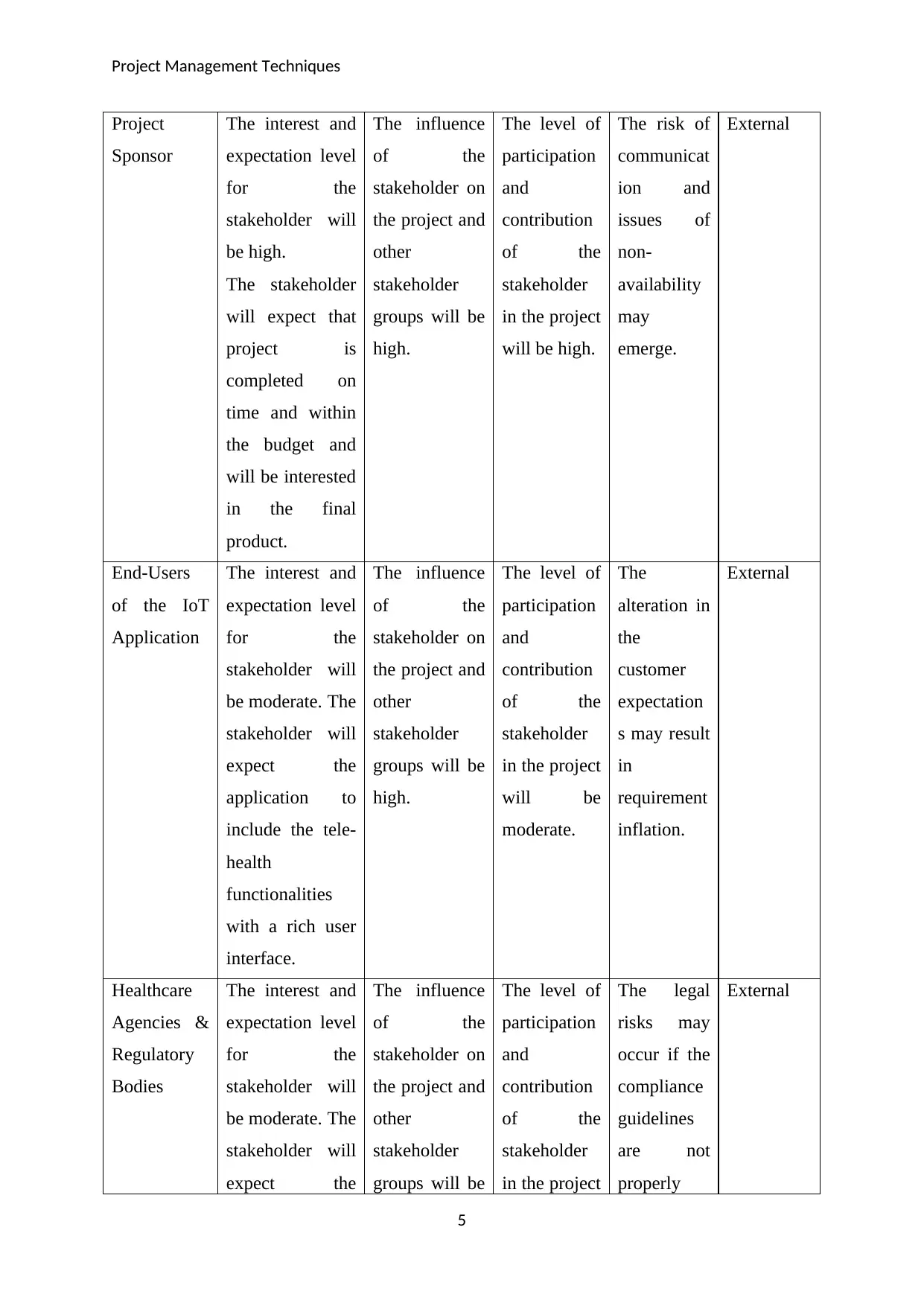
Project Management Techniques
Project
Sponsor
The interest and
expectation level
for the
stakeholder will
be high.
The stakeholder
will expect that
project is
completed on
time and within
the budget and
will be interested
in the final
product.
The influence
of the
stakeholder on
the project and
other
stakeholder
groups will be
high.
The level of
participation
and
contribution
of the
stakeholder
in the project
will be high.
The risk of
communicat
ion and
issues of
non-
availability
may
emerge.
External
End-Users
of the IoT
Application
The interest and
expectation level
for the
stakeholder will
be moderate. The
stakeholder will
expect the
application to
include the tele-
health
functionalities
with a rich user
interface.
The influence
of the
stakeholder on
the project and
other
stakeholder
groups will be
high.
The level of
participation
and
contribution
of the
stakeholder
in the project
will be
moderate.
The
alteration in
the
customer
expectation
s may result
in
requirement
inflation.
External
Healthcare
Agencies &
Regulatory
Bodies
The interest and
expectation level
for the
stakeholder will
be moderate. The
stakeholder will
expect the
The influence
of the
stakeholder on
the project and
other
stakeholder
groups will be
The level of
participation
and
contribution
of the
stakeholder
in the project
The legal
risks may
occur if the
compliance
guidelines
are not
properly
External
5
Project
Sponsor
The interest and
expectation level
for the
stakeholder will
be high.
The stakeholder
will expect that
project is
completed on
time and within
the budget and
will be interested
in the final
product.
The influence
of the
stakeholder on
the project and
other
stakeholder
groups will be
high.
The level of
participation
and
contribution
of the
stakeholder
in the project
will be high.
The risk of
communicat
ion and
issues of
non-
availability
may
emerge.
External
End-Users
of the IoT
Application
The interest and
expectation level
for the
stakeholder will
be moderate. The
stakeholder will
expect the
application to
include the tele-
health
functionalities
with a rich user
interface.
The influence
of the
stakeholder on
the project and
other
stakeholder
groups will be
high.
The level of
participation
and
contribution
of the
stakeholder
in the project
will be
moderate.
The
alteration in
the
customer
expectation
s may result
in
requirement
inflation.
External
Healthcare
Agencies &
Regulatory
Bodies
The interest and
expectation level
for the
stakeholder will
be moderate. The
stakeholder will
expect the
The influence
of the
stakeholder on
the project and
other
stakeholder
groups will be
The level of
participation
and
contribution
of the
stakeholder
in the project
The legal
risks may
occur if the
compliance
guidelines
are not
properly
External
5
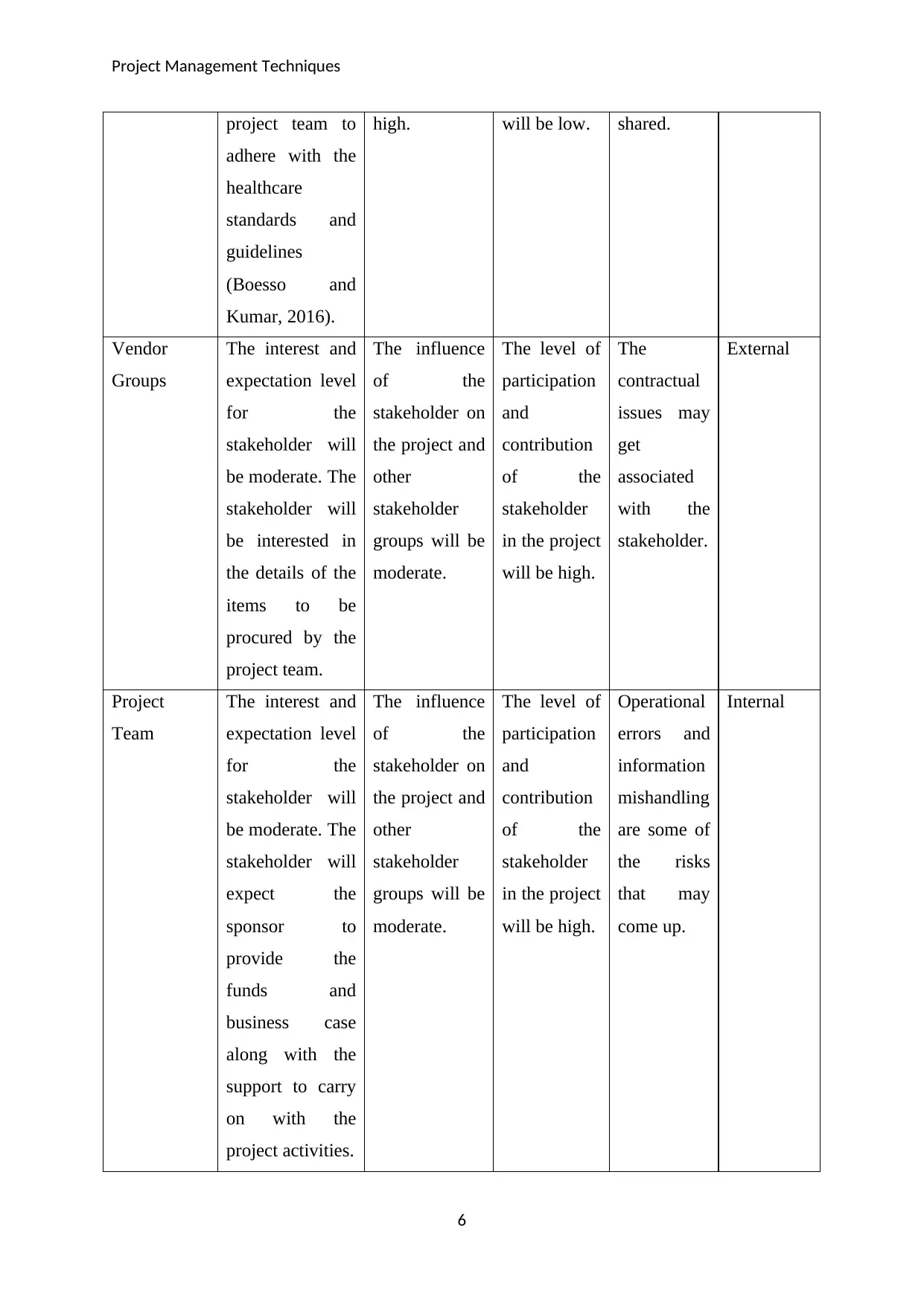
Project Management Techniques
project team to
adhere with the
healthcare
standards and
guidelines
(Boesso and
Kumar, 2016).
high. will be low. shared.
Vendor
Groups
The interest and
expectation level
for the
stakeholder will
be moderate. The
stakeholder will
be interested in
the details of the
items to be
procured by the
project team.
The influence
of the
stakeholder on
the project and
other
stakeholder
groups will be
moderate.
The level of
participation
and
contribution
of the
stakeholder
in the project
will be high.
The
contractual
issues may
get
associated
with the
stakeholder.
External
Project
Team
The interest and
expectation level
for the
stakeholder will
be moderate. The
stakeholder will
expect the
sponsor to
provide the
funds and
business case
along with the
support to carry
on with the
project activities.
The influence
of the
stakeholder on
the project and
other
stakeholder
groups will be
moderate.
The level of
participation
and
contribution
of the
stakeholder
in the project
will be high.
Operational
errors and
information
mishandling
are some of
the risks
that may
come up.
Internal
6
project team to
adhere with the
healthcare
standards and
guidelines
(Boesso and
Kumar, 2016).
high. will be low. shared.
Vendor
Groups
The interest and
expectation level
for the
stakeholder will
be moderate. The
stakeholder will
be interested in
the details of the
items to be
procured by the
project team.
The influence
of the
stakeholder on
the project and
other
stakeholder
groups will be
moderate.
The level of
participation
and
contribution
of the
stakeholder
in the project
will be high.
The
contractual
issues may
get
associated
with the
stakeholder.
External
Project
Team
The interest and
expectation level
for the
stakeholder will
be moderate. The
stakeholder will
expect the
sponsor to
provide the
funds and
business case
along with the
support to carry
on with the
project activities.
The influence
of the
stakeholder on
the project and
other
stakeholder
groups will be
moderate.
The level of
participation
and
contribution
of the
stakeholder
in the project
will be high.
Operational
errors and
information
mishandling
are some of
the risks
that may
come up.
Internal
6
Paraphrase This Document
Need a fresh take? Get an instant paraphrase of this document with our AI Paraphraser
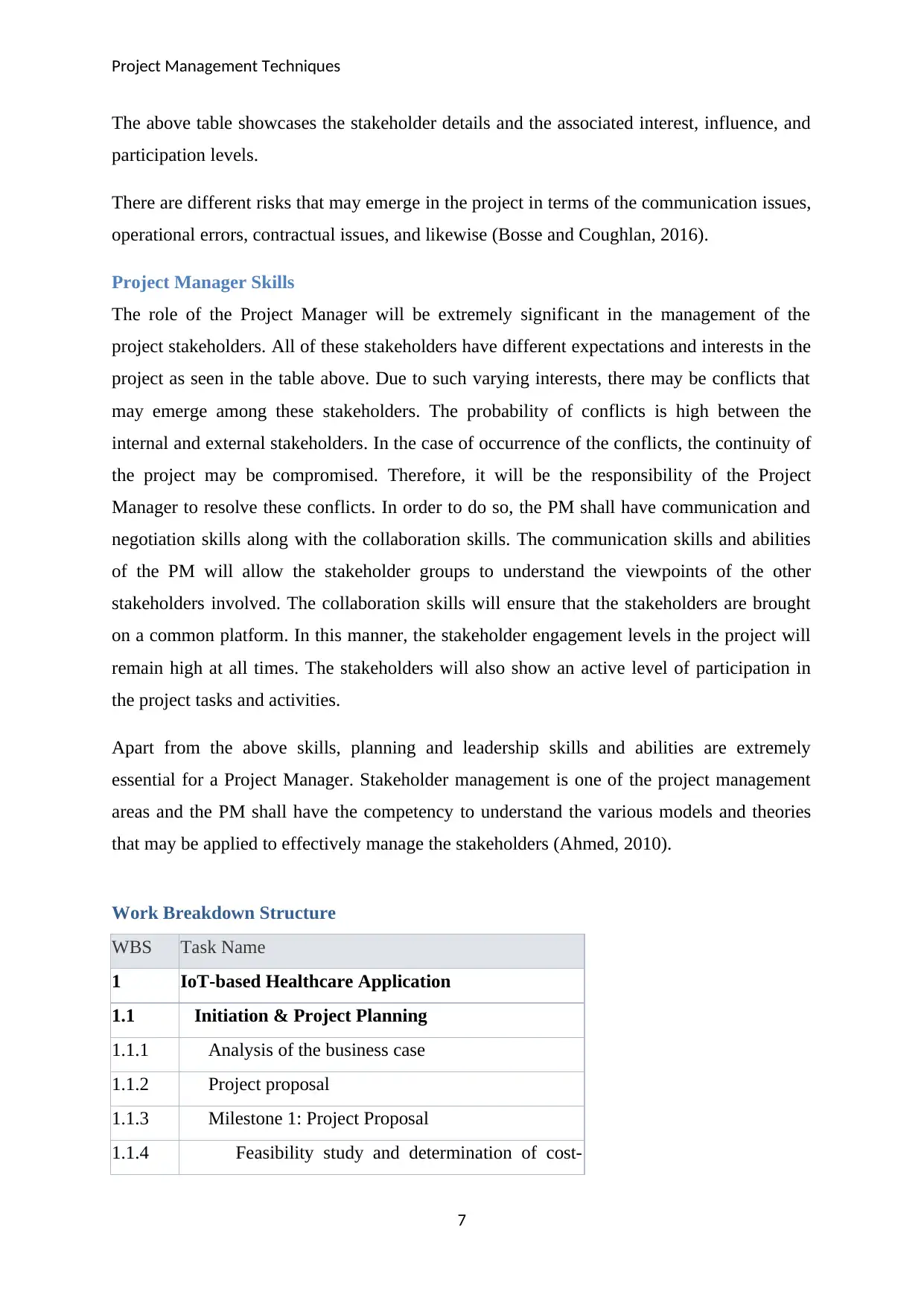
Project Management Techniques
The above table showcases the stakeholder details and the associated interest, influence, and
participation levels.
There are different risks that may emerge in the project in terms of the communication issues,
operational errors, contractual issues, and likewise (Bosse and Coughlan, 2016).
Project Manager Skills
The role of the Project Manager will be extremely significant in the management of the
project stakeholders. All of these stakeholders have different expectations and interests in the
project as seen in the table above. Due to such varying interests, there may be conflicts that
may emerge among these stakeholders. The probability of conflicts is high between the
internal and external stakeholders. In the case of occurrence of the conflicts, the continuity of
the project may be compromised. Therefore, it will be the responsibility of the Project
Manager to resolve these conflicts. In order to do so, the PM shall have communication and
negotiation skills along with the collaboration skills. The communication skills and abilities
of the PM will allow the stakeholder groups to understand the viewpoints of the other
stakeholders involved. The collaboration skills will ensure that the stakeholders are brought
on a common platform. In this manner, the stakeholder engagement levels in the project will
remain high at all times. The stakeholders will also show an active level of participation in
the project tasks and activities.
Apart from the above skills, planning and leadership skills and abilities are extremely
essential for a Project Manager. Stakeholder management is one of the project management
areas and the PM shall have the competency to understand the various models and theories
that may be applied to effectively manage the stakeholders (Ahmed, 2010).
Work Breakdown Structure
WBS Task Name
1 IoT-based Healthcare Application
1.1 Initiation & Project Planning
1.1.1 Analysis of the business case
1.1.2 Project proposal
1.1.3 Milestone 1: Project Proposal
1.1.4 Feasibility study and determination of cost-
7
The above table showcases the stakeholder details and the associated interest, influence, and
participation levels.
There are different risks that may emerge in the project in terms of the communication issues,
operational errors, contractual issues, and likewise (Bosse and Coughlan, 2016).
Project Manager Skills
The role of the Project Manager will be extremely significant in the management of the
project stakeholders. All of these stakeholders have different expectations and interests in the
project as seen in the table above. Due to such varying interests, there may be conflicts that
may emerge among these stakeholders. The probability of conflicts is high between the
internal and external stakeholders. In the case of occurrence of the conflicts, the continuity of
the project may be compromised. Therefore, it will be the responsibility of the Project
Manager to resolve these conflicts. In order to do so, the PM shall have communication and
negotiation skills along with the collaboration skills. The communication skills and abilities
of the PM will allow the stakeholder groups to understand the viewpoints of the other
stakeholders involved. The collaboration skills will ensure that the stakeholders are brought
on a common platform. In this manner, the stakeholder engagement levels in the project will
remain high at all times. The stakeholders will also show an active level of participation in
the project tasks and activities.
Apart from the above skills, planning and leadership skills and abilities are extremely
essential for a Project Manager. Stakeholder management is one of the project management
areas and the PM shall have the competency to understand the various models and theories
that may be applied to effectively manage the stakeholders (Ahmed, 2010).
Work Breakdown Structure
WBS Task Name
1 IoT-based Healthcare Application
1.1 Initiation & Project Planning
1.1.1 Analysis of the business case
1.1.2 Project proposal
1.1.3 Milestone 1: Project Proposal
1.1.4 Feasibility study and determination of cost-
7
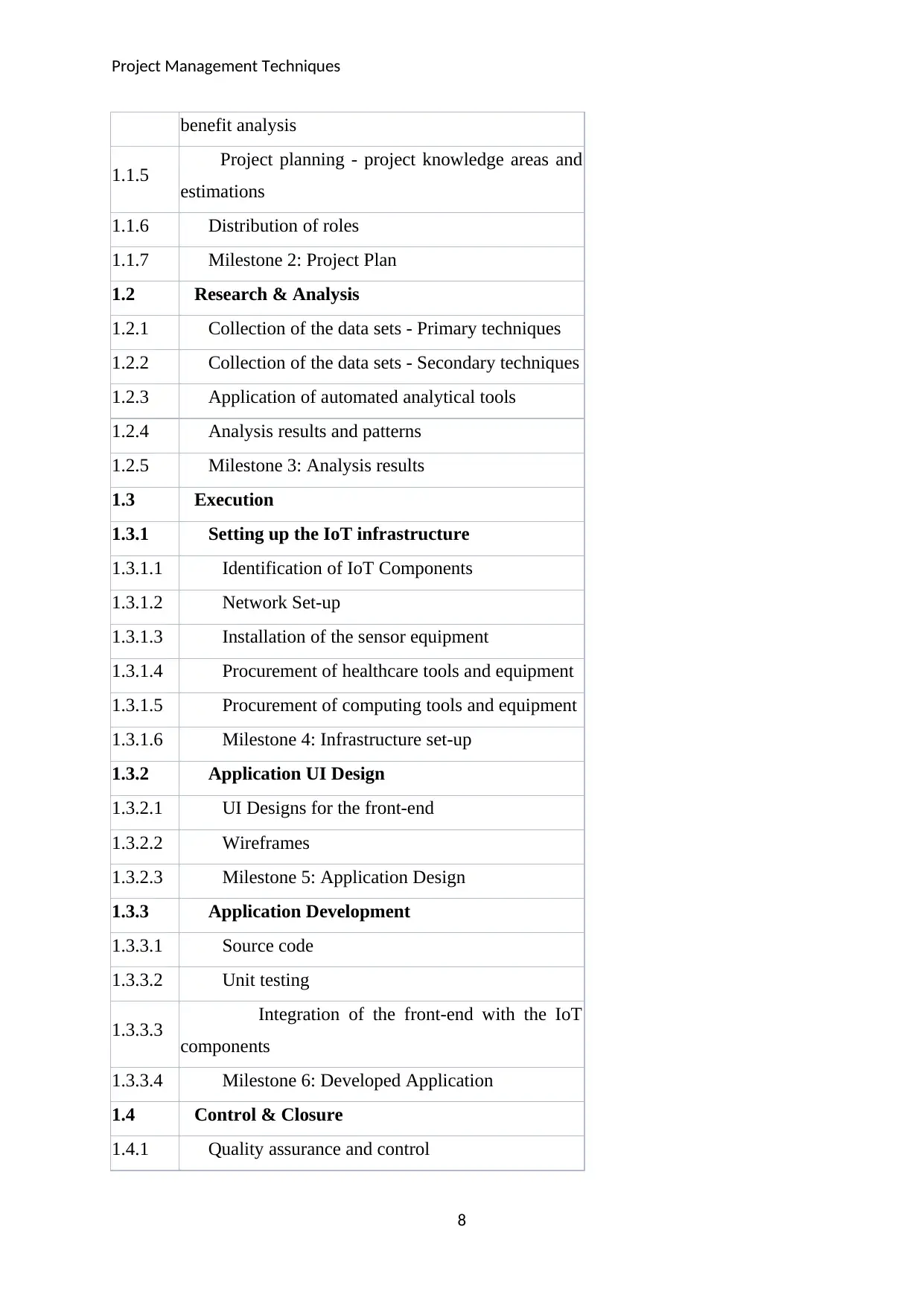
Project Management Techniques
benefit analysis
1.1.5 Project planning - project knowledge areas and
estimations
1.1.6 Distribution of roles
1.1.7 Milestone 2: Project Plan
1.2 Research & Analysis
1.2.1 Collection of the data sets - Primary techniques
1.2.2 Collection of the data sets - Secondary techniques
1.2.3 Application of automated analytical tools
1.2.4 Analysis results and patterns
1.2.5 Milestone 3: Analysis results
1.3 Execution
1.3.1 Setting up the IoT infrastructure
1.3.1.1 Identification of IoT Components
1.3.1.2 Network Set-up
1.3.1.3 Installation of the sensor equipment
1.3.1.4 Procurement of healthcare tools and equipment
1.3.1.5 Procurement of computing tools and equipment
1.3.1.6 Milestone 4: Infrastructure set-up
1.3.2 Application UI Design
1.3.2.1 UI Designs for the front-end
1.3.2.2 Wireframes
1.3.2.3 Milestone 5: Application Design
1.3.3 Application Development
1.3.3.1 Source code
1.3.3.2 Unit testing
1.3.3.3 Integration of the front-end with the IoT
components
1.3.3.4 Milestone 6: Developed Application
1.4 Control & Closure
1.4.1 Quality assurance and control
8
benefit analysis
1.1.5 Project planning - project knowledge areas and
estimations
1.1.6 Distribution of roles
1.1.7 Milestone 2: Project Plan
1.2 Research & Analysis
1.2.1 Collection of the data sets - Primary techniques
1.2.2 Collection of the data sets - Secondary techniques
1.2.3 Application of automated analytical tools
1.2.4 Analysis results and patterns
1.2.5 Milestone 3: Analysis results
1.3 Execution
1.3.1 Setting up the IoT infrastructure
1.3.1.1 Identification of IoT Components
1.3.1.2 Network Set-up
1.3.1.3 Installation of the sensor equipment
1.3.1.4 Procurement of healthcare tools and equipment
1.3.1.5 Procurement of computing tools and equipment
1.3.1.6 Milestone 4: Infrastructure set-up
1.3.2 Application UI Design
1.3.2.1 UI Designs for the front-end
1.3.2.2 Wireframes
1.3.2.3 Milestone 5: Application Design
1.3.3 Application Development
1.3.3.1 Source code
1.3.3.2 Unit testing
1.3.3.3 Integration of the front-end with the IoT
components
1.3.3.4 Milestone 6: Developed Application
1.4 Control & Closure
1.4.1 Quality assurance and control
8

Project Management Techniques
1.4.2 Implementation and change management
1.4.3 Reflection and documentation
1.4.4 Final closure
1.4.5 Milestone 7: Closure Report
Key Skills of Project Manager
The Work Breakdown Structure showcases the project outline in the form of the phases and
activities that will be involved.
The management of these activities will be on the Project Manager. It will be necessary for
the PM to determine the status of each of these activities to make sure that the deliverables
are provided to the stakeholders on time. There will be numerous skills required for this
purpose. The first and the foremost are planning and leadership skills. There are numerous
areas involved in the project and the management of all of these areas cannot be done without
an effective plan. PM shall have the skills to plan each of these activities and carry out the
estimations on the project areas, such as schedule, budget, and resources. The project
resources and stakeholders cannot be efficiently managed without the leadership skills. The
majority of the project resources and stakeholders have distinctive desires and interests in the
project. Because of such differing interests, there might be conflicts that may arise among
these stakeholders. The likelihood of conflicts is high between the inner and outer
9
IoT-based
Healthcare
Application
Initiation & Project
Planning
Analysis of the
business case
Project proposal
Milestone 1:
Project Proposal
Feasibility study
and determination
of cost-benefit
analysis
Project planning -
project knowledge
areas and
estimations
Distribution of
roles
Milestone 2:
Project Plan
Research &
Analysis
Collection of the
data sets - Primary
techniques
Collection of the
data sets -
Secondary
techniques
Application of
automated
analytical tools
Analysis results and
patterns
Milestone 3:
Analysis results
Execution
Setting up the IoT
infrastructure
Identification of IoT
Components
Network Set-up
Installation of the
sensor equipment
Procurement of
healthcare tools
and equipment
Procurement of
computing tools
and equipment
Milestone 4:
Infrastructure set-
up
Application UI
Design
UI Designs for the
front-end
Wireframes
Milestone 5:
Application Design
Application
Development
Source code
Unit testing
Integration of the
front-end with the
IoT components
Milestone 6:
Developed
Application
Control & Closure
Quality assurance
and control
Implementation
and change
management
Reflection and
documentation
Final closure
Milestone 7:
Closure Report
1.4.2 Implementation and change management
1.4.3 Reflection and documentation
1.4.4 Final closure
1.4.5 Milestone 7: Closure Report
Key Skills of Project Manager
The Work Breakdown Structure showcases the project outline in the form of the phases and
activities that will be involved.
The management of these activities will be on the Project Manager. It will be necessary for
the PM to determine the status of each of these activities to make sure that the deliverables
are provided to the stakeholders on time. There will be numerous skills required for this
purpose. The first and the foremost are planning and leadership skills. There are numerous
areas involved in the project and the management of all of these areas cannot be done without
an effective plan. PM shall have the skills to plan each of these activities and carry out the
estimations on the project areas, such as schedule, budget, and resources. The project
resources and stakeholders cannot be efficiently managed without the leadership skills. The
majority of the project resources and stakeholders have distinctive desires and interests in the
project. Because of such differing interests, there might be conflicts that may arise among
these stakeholders. The likelihood of conflicts is high between the inner and outer
9
IoT-based
Healthcare
Application
Initiation & Project
Planning
Analysis of the
business case
Project proposal
Milestone 1:
Project Proposal
Feasibility study
and determination
of cost-benefit
analysis
Project planning -
project knowledge
areas and
estimations
Distribution of
roles
Milestone 2:
Project Plan
Research &
Analysis
Collection of the
data sets - Primary
techniques
Collection of the
data sets -
Secondary
techniques
Application of
automated
analytical tools
Analysis results and
patterns
Milestone 3:
Analysis results
Execution
Setting up the IoT
infrastructure
Identification of IoT
Components
Network Set-up
Installation of the
sensor equipment
Procurement of
healthcare tools
and equipment
Procurement of
computing tools
and equipment
Milestone 4:
Infrastructure set-
up
Application UI
Design
UI Designs for the
front-end
Wireframes
Milestone 5:
Application Design
Application
Development
Source code
Unit testing
Integration of the
front-end with the
IoT components
Milestone 6:
Developed
Application
Control & Closure
Quality assurance
and control
Implementation
and change
management
Reflection and
documentation
Final closure
Milestone 7:
Closure Report
Secure Best Marks with AI Grader
Need help grading? Try our AI Grader for instant feedback on your assignments.
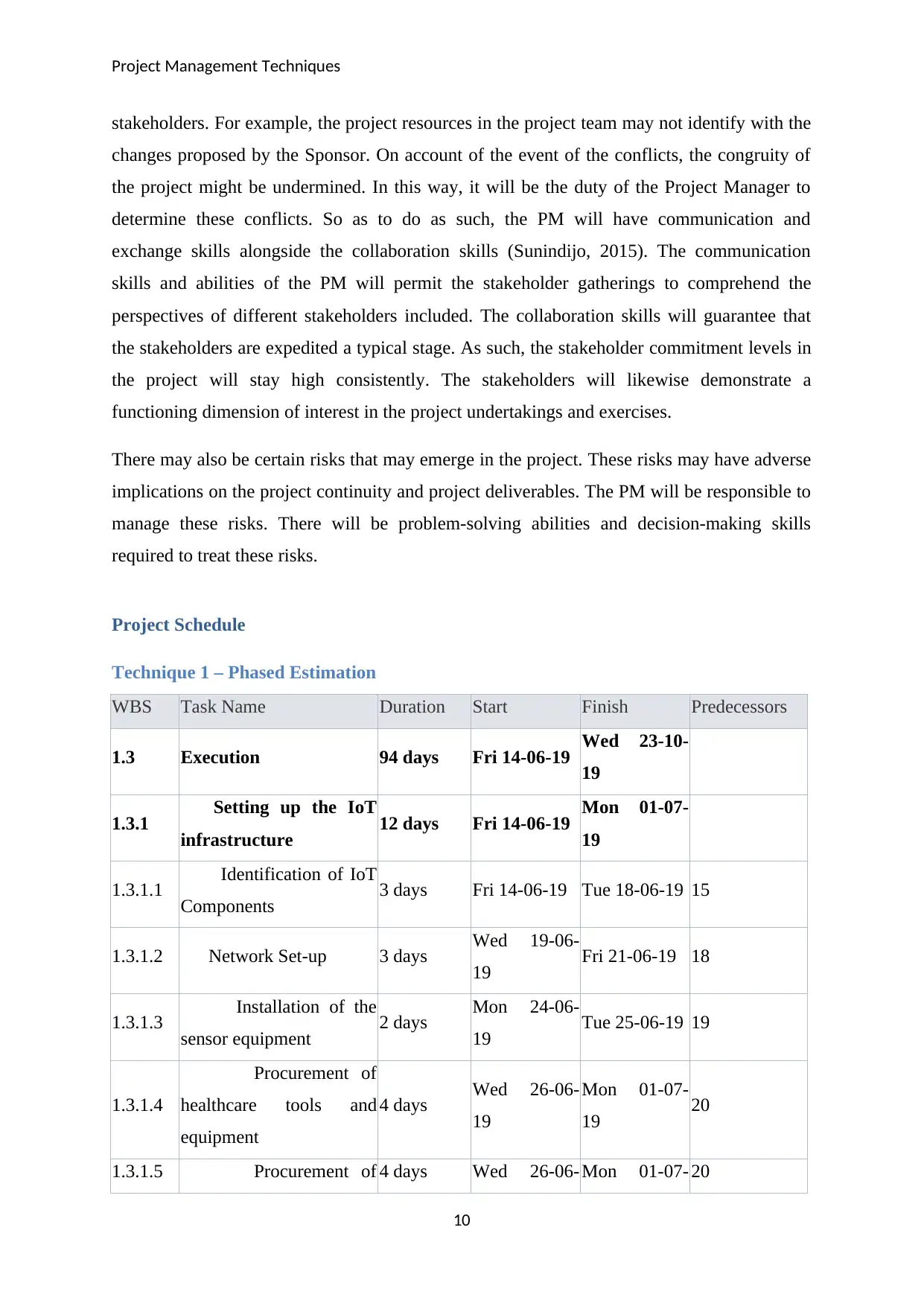
Project Management Techniques
stakeholders. For example, the project resources in the project team may not identify with the
changes proposed by the Sponsor. On account of the event of the conflicts, the congruity of
the project might be undermined. In this way, it will be the duty of the Project Manager to
determine these conflicts. So as to do as such, the PM will have communication and
exchange skills alongside the collaboration skills (Sunindijo, 2015). The communication
skills and abilities of the PM will permit the stakeholder gatherings to comprehend the
perspectives of different stakeholders included. The collaboration skills will guarantee that
the stakeholders are expedited a typical stage. As such, the stakeholder commitment levels in
the project will stay high consistently. The stakeholders will likewise demonstrate a
functioning dimension of interest in the project undertakings and exercises.
There may also be certain risks that may emerge in the project. These risks may have adverse
implications on the project continuity and project deliverables. The PM will be responsible to
manage these risks. There will be problem-solving abilities and decision-making skills
required to treat these risks.
Project Schedule
Technique 1 – Phased Estimation
WBS Task Name Duration Start Finish Predecessors
1.3 Execution 94 days Fri 14-06-19 Wed 23-10-
19
1.3.1 Setting up the IoT
infrastructure 12 days Fri 14-06-19 Mon 01-07-
19
1.3.1.1 Identification of IoT
Components 3 days Fri 14-06-19 Tue 18-06-19 15
1.3.1.2 Network Set-up 3 days Wed 19-06-
19 Fri 21-06-19 18
1.3.1.3 Installation of the
sensor equipment 2 days Mon 24-06-
19 Tue 25-06-19 19
1.3.1.4
Procurement of
healthcare tools and
equipment
4 days Wed 26-06-
19
Mon 01-07-
19 20
1.3.1.5 Procurement of 4 days Wed 26-06- Mon 01-07- 20
10
stakeholders. For example, the project resources in the project team may not identify with the
changes proposed by the Sponsor. On account of the event of the conflicts, the congruity of
the project might be undermined. In this way, it will be the duty of the Project Manager to
determine these conflicts. So as to do as such, the PM will have communication and
exchange skills alongside the collaboration skills (Sunindijo, 2015). The communication
skills and abilities of the PM will permit the stakeholder gatherings to comprehend the
perspectives of different stakeholders included. The collaboration skills will guarantee that
the stakeholders are expedited a typical stage. As such, the stakeholder commitment levels in
the project will stay high consistently. The stakeholders will likewise demonstrate a
functioning dimension of interest in the project undertakings and exercises.
There may also be certain risks that may emerge in the project. These risks may have adverse
implications on the project continuity and project deliverables. The PM will be responsible to
manage these risks. There will be problem-solving abilities and decision-making skills
required to treat these risks.
Project Schedule
Technique 1 – Phased Estimation
WBS Task Name Duration Start Finish Predecessors
1.3 Execution 94 days Fri 14-06-19 Wed 23-10-
19
1.3.1 Setting up the IoT
infrastructure 12 days Fri 14-06-19 Mon 01-07-
19
1.3.1.1 Identification of IoT
Components 3 days Fri 14-06-19 Tue 18-06-19 15
1.3.1.2 Network Set-up 3 days Wed 19-06-
19 Fri 21-06-19 18
1.3.1.3 Installation of the
sensor equipment 2 days Mon 24-06-
19 Tue 25-06-19 19
1.3.1.4
Procurement of
healthcare tools and
equipment
4 days Wed 26-06-
19
Mon 01-07-
19 20
1.3.1.5 Procurement of 4 days Wed 26-06- Mon 01-07- 20
10
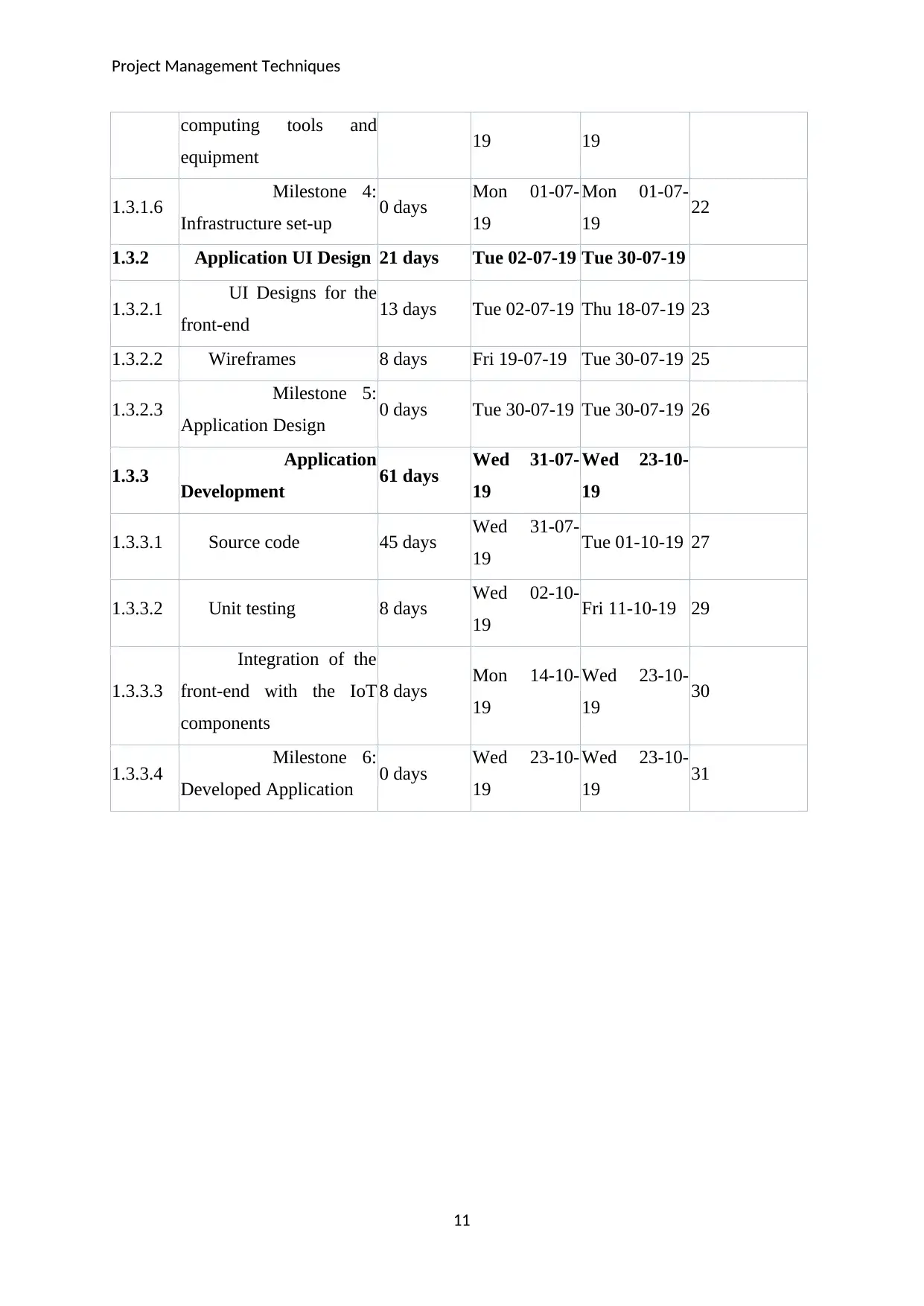
Project Management Techniques
computing tools and
equipment 19 19
1.3.1.6 Milestone 4:
Infrastructure set-up 0 days Mon 01-07-
19
Mon 01-07-
19 22
1.3.2 Application UI Design 21 days Tue 02-07-19 Tue 30-07-19
1.3.2.1 UI Designs for the
front-end 13 days Tue 02-07-19 Thu 18-07-19 23
1.3.2.2 Wireframes 8 days Fri 19-07-19 Tue 30-07-19 25
1.3.2.3 Milestone 5:
Application Design 0 days Tue 30-07-19 Tue 30-07-19 26
1.3.3 Application
Development 61 days Wed 31-07-
19
Wed 23-10-
19
1.3.3.1 Source code 45 days Wed 31-07-
19 Tue 01-10-19 27
1.3.3.2 Unit testing 8 days Wed 02-10-
19 Fri 11-10-19 29
1.3.3.3
Integration of the
front-end with the IoT
components
8 days Mon 14-10-
19
Wed 23-10-
19 30
1.3.3.4 Milestone 6:
Developed Application 0 days Wed 23-10-
19
Wed 23-10-
19 31
11
computing tools and
equipment 19 19
1.3.1.6 Milestone 4:
Infrastructure set-up 0 days Mon 01-07-
19
Mon 01-07-
19 22
1.3.2 Application UI Design 21 days Tue 02-07-19 Tue 30-07-19
1.3.2.1 UI Designs for the
front-end 13 days Tue 02-07-19 Thu 18-07-19 23
1.3.2.2 Wireframes 8 days Fri 19-07-19 Tue 30-07-19 25
1.3.2.3 Milestone 5:
Application Design 0 days Tue 30-07-19 Tue 30-07-19 26
1.3.3 Application
Development 61 days Wed 31-07-
19
Wed 23-10-
19
1.3.3.1 Source code 45 days Wed 31-07-
19 Tue 01-10-19 27
1.3.3.2 Unit testing 8 days Wed 02-10-
19 Fri 11-10-19 29
1.3.3.3
Integration of the
front-end with the IoT
components
8 days Mon 14-10-
19
Wed 23-10-
19 30
1.3.3.4 Milestone 6:
Developed Application 0 days Wed 23-10-
19
Wed 23-10-
19 31
11
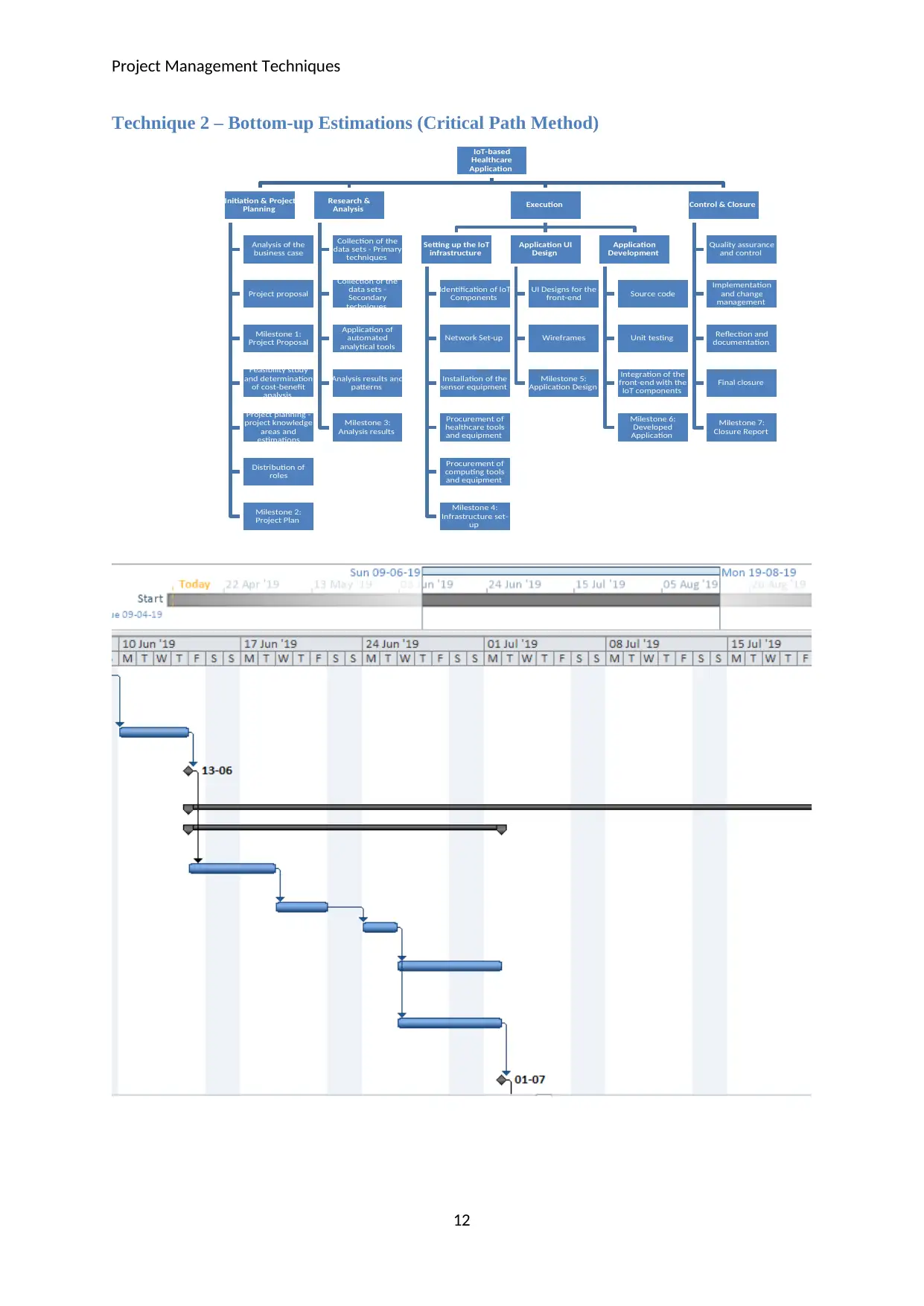
Project Management Techniques
Technique 2 – Bottom-up Estimations (Critical Path Method)
12
IoT-based
Healthcare
Application
Initiation & Project
Planning
Analysis of the
business case
Project proposal
Milestone 1:
Project Proposal
Feasibility study
and determination
of cost-benefit
analysis
Project planning -
project knowledge
areas and
estimations
Distribution of
roles
Milestone 2:
Project Plan
Research &
Analysis
Collection of the
data sets - Primary
techniques
Collection of the
data sets -
Secondary
techniques
Application of
automated
analytical tools
Analysis results and
patterns
Milestone 3:
Analysis results
Execution
Setting up the IoT
infrastructure
Identification of IoT
Components
Network Set-up
Installation of the
sensor equipment
Procurement of
healthcare tools
and equipment
Procurement of
computing tools
and equipment
Milestone 4:
Infrastructure set-
up
Application UI
Design
UI Designs for the
front-end
Wireframes
Milestone 5:
Application Design
Application
Development
Source code
Unit testing
Integration of the
front-end with the
IoT components
Milestone 6:
Developed
Application
Control & Closure
Quality assurance
and control
Implementation
and change
management
Reflection and
documentation
Final closure
Milestone 7:
Closure Report
Technique 2 – Bottom-up Estimations (Critical Path Method)
12
IoT-based
Healthcare
Application
Initiation & Project
Planning
Analysis of the
business case
Project proposal
Milestone 1:
Project Proposal
Feasibility study
and determination
of cost-benefit
analysis
Project planning -
project knowledge
areas and
estimations
Distribution of
roles
Milestone 2:
Project Plan
Research &
Analysis
Collection of the
data sets - Primary
techniques
Collection of the
data sets -
Secondary
techniques
Application of
automated
analytical tools
Analysis results and
patterns
Milestone 3:
Analysis results
Execution
Setting up the IoT
infrastructure
Identification of IoT
Components
Network Set-up
Installation of the
sensor equipment
Procurement of
healthcare tools
and equipment
Procurement of
computing tools
and equipment
Milestone 4:
Infrastructure set-
up
Application UI
Design
UI Designs for the
front-end
Wireframes
Milestone 5:
Application Design
Application
Development
Source code
Unit testing
Integration of the
front-end with the
IoT components
Milestone 6:
Developed
Application
Control & Closure
Quality assurance
and control
Implementation
and change
management
Reflection and
documentation
Final closure
Milestone 7:
Closure Report
Paraphrase This Document
Need a fresh take? Get an instant paraphrase of this document with our AI Paraphraser
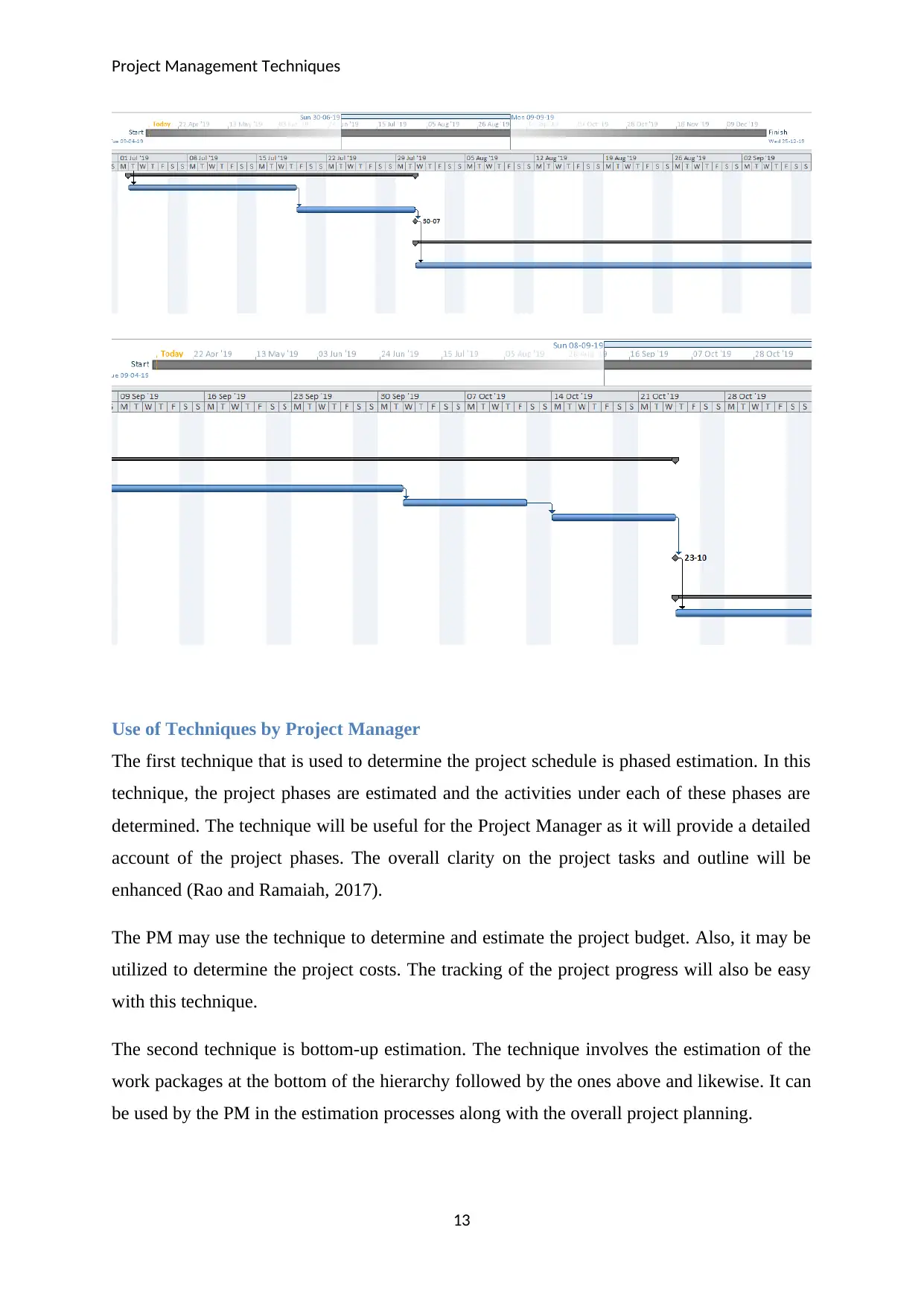
Project Management Techniques
Use of Techniques by Project Manager
The first technique that is used to determine the project schedule is phased estimation. In this
technique, the project phases are estimated and the activities under each of these phases are
determined. The technique will be useful for the Project Manager as it will provide a detailed
account of the project phases. The overall clarity on the project tasks and outline will be
enhanced (Rao and Ramaiah, 2017).
The PM may use the technique to determine and estimate the project budget. Also, it may be
utilized to determine the project costs. The tracking of the project progress will also be easy
with this technique.
The second technique is bottom-up estimation. The technique involves the estimation of the
work packages at the bottom of the hierarchy followed by the ones above and likewise. It can
be used by the PM in the estimation processes along with the overall project planning.
13
Use of Techniques by Project Manager
The first technique that is used to determine the project schedule is phased estimation. In this
technique, the project phases are estimated and the activities under each of these phases are
determined. The technique will be useful for the Project Manager as it will provide a detailed
account of the project phases. The overall clarity on the project tasks and outline will be
enhanced (Rao and Ramaiah, 2017).
The PM may use the technique to determine and estimate the project budget. Also, it may be
utilized to determine the project costs. The tracking of the project progress will also be easy
with this technique.
The second technique is bottom-up estimation. The technique involves the estimation of the
work packages at the bottom of the hierarchy followed by the ones above and likewise. It can
be used by the PM in the estimation processes along with the overall project planning.
13
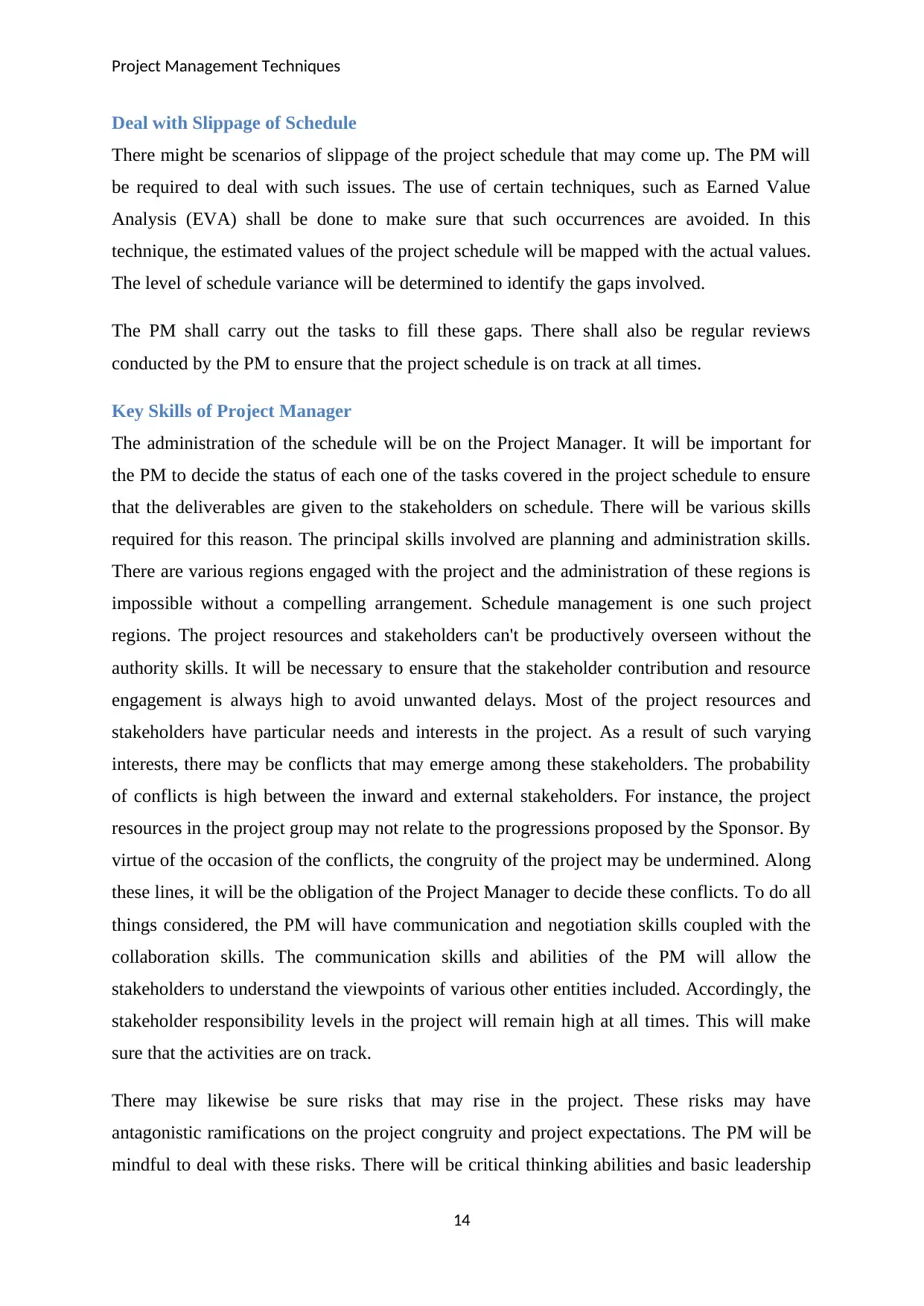
Project Management Techniques
Deal with Slippage of Schedule
There might be scenarios of slippage of the project schedule that may come up. The PM will
be required to deal with such issues. The use of certain techniques, such as Earned Value
Analysis (EVA) shall be done to make sure that such occurrences are avoided. In this
technique, the estimated values of the project schedule will be mapped with the actual values.
The level of schedule variance will be determined to identify the gaps involved.
The PM shall carry out the tasks to fill these gaps. There shall also be regular reviews
conducted by the PM to ensure that the project schedule is on track at all times.
Key Skills of Project Manager
The administration of the schedule will be on the Project Manager. It will be important for
the PM to decide the status of each one of the tasks covered in the project schedule to ensure
that the deliverables are given to the stakeholders on schedule. There will be various skills
required for this reason. The principal skills involved are planning and administration skills.
There are various regions engaged with the project and the administration of these regions is
impossible without a compelling arrangement. Schedule management is one such project
regions. The project resources and stakeholders can't be productively overseen without the
authority skills. It will be necessary to ensure that the stakeholder contribution and resource
engagement is always high to avoid unwanted delays. Most of the project resources and
stakeholders have particular needs and interests in the project. As a result of such varying
interests, there may be conflicts that may emerge among these stakeholders. The probability
of conflicts is high between the inward and external stakeholders. For instance, the project
resources in the project group may not relate to the progressions proposed by the Sponsor. By
virtue of the occasion of the conflicts, the congruity of the project may be undermined. Along
these lines, it will be the obligation of the Project Manager to decide these conflicts. To do all
things considered, the PM will have communication and negotiation skills coupled with the
collaboration skills. The communication skills and abilities of the PM will allow the
stakeholders to understand the viewpoints of various other entities included. Accordingly, the
stakeholder responsibility levels in the project will remain high at all times. This will make
sure that the activities are on track.
There may likewise be sure risks that may rise in the project. These risks may have
antagonistic ramifications on the project congruity and project expectations. The PM will be
mindful to deal with these risks. There will be critical thinking abilities and basic leadership
14
Deal with Slippage of Schedule
There might be scenarios of slippage of the project schedule that may come up. The PM will
be required to deal with such issues. The use of certain techniques, such as Earned Value
Analysis (EVA) shall be done to make sure that such occurrences are avoided. In this
technique, the estimated values of the project schedule will be mapped with the actual values.
The level of schedule variance will be determined to identify the gaps involved.
The PM shall carry out the tasks to fill these gaps. There shall also be regular reviews
conducted by the PM to ensure that the project schedule is on track at all times.
Key Skills of Project Manager
The administration of the schedule will be on the Project Manager. It will be important for
the PM to decide the status of each one of the tasks covered in the project schedule to ensure
that the deliverables are given to the stakeholders on schedule. There will be various skills
required for this reason. The principal skills involved are planning and administration skills.
There are various regions engaged with the project and the administration of these regions is
impossible without a compelling arrangement. Schedule management is one such project
regions. The project resources and stakeholders can't be productively overseen without the
authority skills. It will be necessary to ensure that the stakeholder contribution and resource
engagement is always high to avoid unwanted delays. Most of the project resources and
stakeholders have particular needs and interests in the project. As a result of such varying
interests, there may be conflicts that may emerge among these stakeholders. The probability
of conflicts is high between the inward and external stakeholders. For instance, the project
resources in the project group may not relate to the progressions proposed by the Sponsor. By
virtue of the occasion of the conflicts, the congruity of the project may be undermined. Along
these lines, it will be the obligation of the Project Manager to decide these conflicts. To do all
things considered, the PM will have communication and negotiation skills coupled with the
collaboration skills. The communication skills and abilities of the PM will allow the
stakeholders to understand the viewpoints of various other entities included. Accordingly, the
stakeholder responsibility levels in the project will remain high at all times. This will make
sure that the activities are on track.
There may likewise be sure risks that may rise in the project. These risks may have
antagonistic ramifications on the project congruity and project expectations. The PM will be
mindful to deal with these risks. There will be critical thinking abilities and basic leadership
14
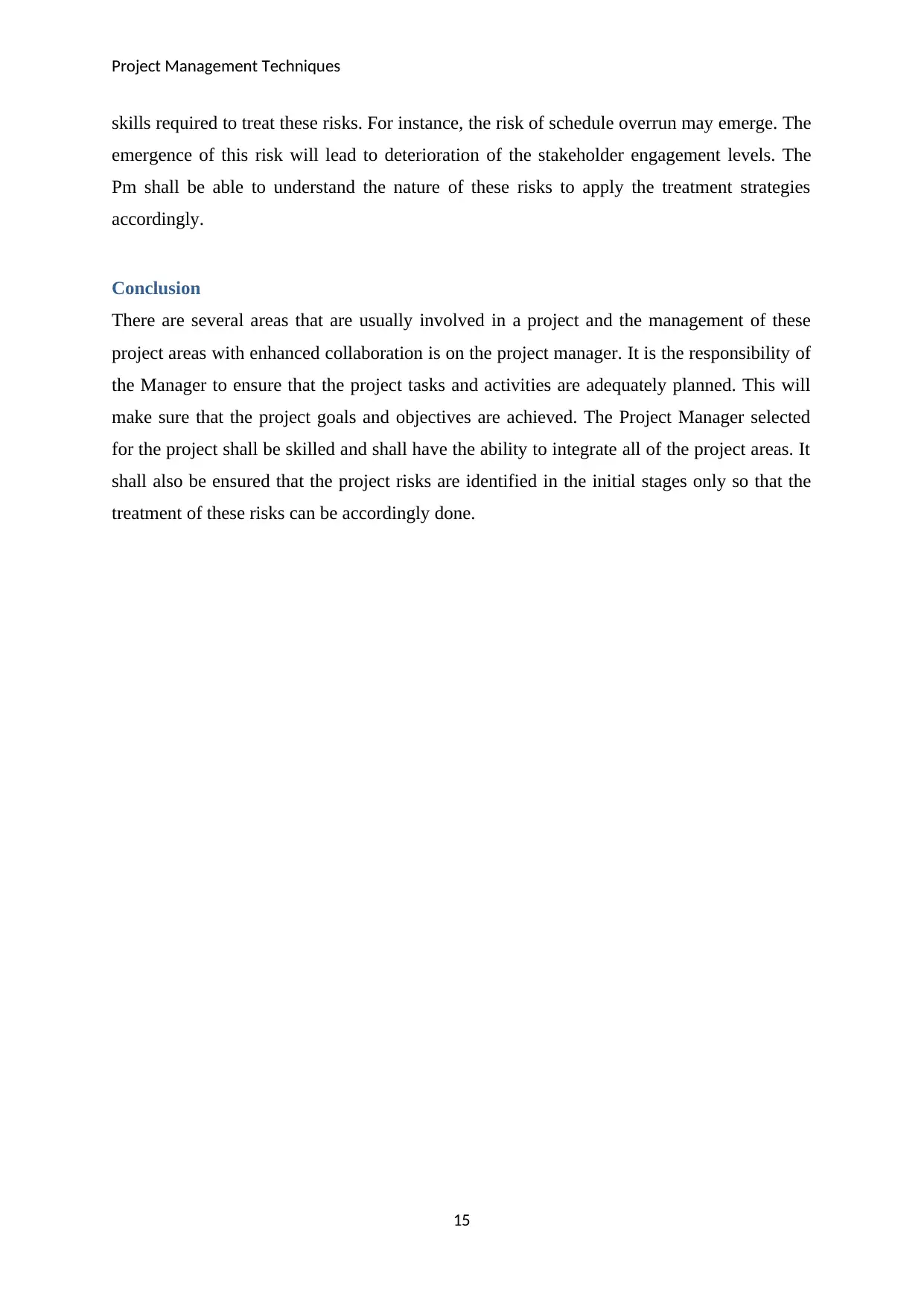
Project Management Techniques
skills required to treat these risks. For instance, the risk of schedule overrun may emerge. The
emergence of this risk will lead to deterioration of the stakeholder engagement levels. The
Pm shall be able to understand the nature of these risks to apply the treatment strategies
accordingly.
Conclusion
There are several areas that are usually involved in a project and the management of these
project areas with enhanced collaboration is on the project manager. It is the responsibility of
the Manager to ensure that the project tasks and activities are adequately planned. This will
make sure that the project goals and objectives are achieved. The Project Manager selected
for the project shall be skilled and shall have the ability to integrate all of the project areas. It
shall also be ensured that the project risks are identified in the initial stages only so that the
treatment of these risks can be accordingly done.
15
skills required to treat these risks. For instance, the risk of schedule overrun may emerge. The
emergence of this risk will lead to deterioration of the stakeholder engagement levels. The
Pm shall be able to understand the nature of these risks to apply the treatment strategies
accordingly.
Conclusion
There are several areas that are usually involved in a project and the management of these
project areas with enhanced collaboration is on the project manager. It is the responsibility of
the Manager to ensure that the project tasks and activities are adequately planned. This will
make sure that the project goals and objectives are achieved. The Project Manager selected
for the project shall be skilled and shall have the ability to integrate all of the project areas. It
shall also be ensured that the project risks are identified in the initial stages only so that the
treatment of these risks can be accordingly done.
15
Secure Best Marks with AI Grader
Need help grading? Try our AI Grader for instant feedback on your assignments.
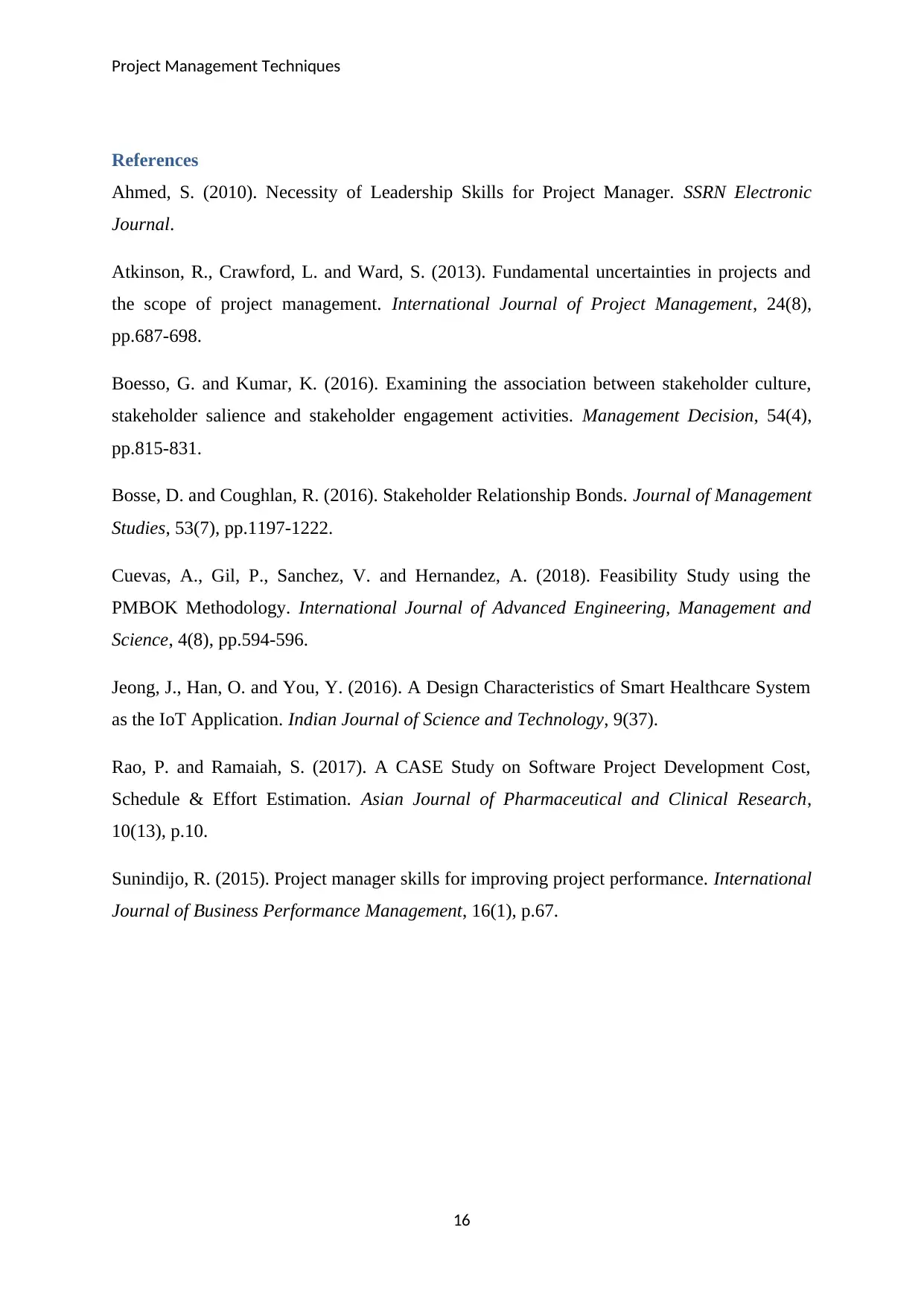
Project Management Techniques
References
Ahmed, S. (2010). Necessity of Leadership Skills for Project Manager. SSRN Electronic
Journal.
Atkinson, R., Crawford, L. and Ward, S. (2013). Fundamental uncertainties in projects and
the scope of project management. International Journal of Project Management, 24(8),
pp.687-698.
Boesso, G. and Kumar, K. (2016). Examining the association between stakeholder culture,
stakeholder salience and stakeholder engagement activities. Management Decision, 54(4),
pp.815-831.
Bosse, D. and Coughlan, R. (2016). Stakeholder Relationship Bonds. Journal of Management
Studies, 53(7), pp.1197-1222.
Cuevas, A., Gil, P., Sanchez, V. and Hernandez, A. (2018). Feasibility Study using the
PMBOK Methodology. International Journal of Advanced Engineering, Management and
Science, 4(8), pp.594-596.
Jeong, J., Han, O. and You, Y. (2016). A Design Characteristics of Smart Healthcare System
as the IoT Application. Indian Journal of Science and Technology, 9(37).
Rao, P. and Ramaiah, S. (2017). A CASE Study on Software Project Development Cost,
Schedule & Effort Estimation. Asian Journal of Pharmaceutical and Clinical Research,
10(13), p.10.
Sunindijo, R. (2015). Project manager skills for improving project performance. International
Journal of Business Performance Management, 16(1), p.67.
16
References
Ahmed, S. (2010). Necessity of Leadership Skills for Project Manager. SSRN Electronic
Journal.
Atkinson, R., Crawford, L. and Ward, S. (2013). Fundamental uncertainties in projects and
the scope of project management. International Journal of Project Management, 24(8),
pp.687-698.
Boesso, G. and Kumar, K. (2016). Examining the association between stakeholder culture,
stakeholder salience and stakeholder engagement activities. Management Decision, 54(4),
pp.815-831.
Bosse, D. and Coughlan, R. (2016). Stakeholder Relationship Bonds. Journal of Management
Studies, 53(7), pp.1197-1222.
Cuevas, A., Gil, P., Sanchez, V. and Hernandez, A. (2018). Feasibility Study using the
PMBOK Methodology. International Journal of Advanced Engineering, Management and
Science, 4(8), pp.594-596.
Jeong, J., Han, O. and You, Y. (2016). A Design Characteristics of Smart Healthcare System
as the IoT Application. Indian Journal of Science and Technology, 9(37).
Rao, P. and Ramaiah, S. (2017). A CASE Study on Software Project Development Cost,
Schedule & Effort Estimation. Asian Journal of Pharmaceutical and Clinical Research,
10(13), p.10.
Sunindijo, R. (2015). Project manager skills for improving project performance. International
Journal of Business Performance Management, 16(1), p.67.
16
1 out of 17
Related Documents
Your All-in-One AI-Powered Toolkit for Academic Success.
+13062052269
info@desklib.com
Available 24*7 on WhatsApp / Email
![[object Object]](/_next/static/media/star-bottom.7253800d.svg)
Unlock your academic potential
© 2024 | Zucol Services PVT LTD | All rights reserved.





